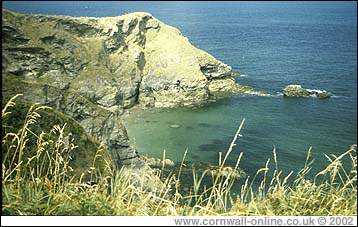Diving in Cornwall

Diving in Cornwall
|
Thanks to Mark Milburn of Atlantic Scuba - Scuba Diving Centre for help with updates to local suppliers
|
|||||||||||
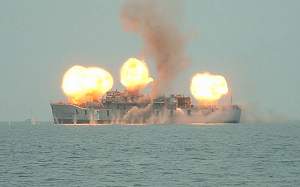 |
|||||||||||
|
|||||||||||
| Dec 2011 - commercial fishing net caught up on a section of the ship’s superstructure. | |||||||||||
|
March 2012 - Successful removal of fishing nets from the Scylla reef. |
|||||||||||
|
Diving Lessons, Equipment |
|||||||||||
|
Atlantic Scuba - Scuba Diving Centre Atlantic Scuba is based near Falmouth in Cornwall, with our dive boat moored at Mylor in the Fal Estuary. Specialising in diving around Falmouth Bay and the Manacles, the area is ideal as it is protected from the predominant south westerly winds. With years of Scuba Diving experience in Cornwall from Padstow to Plymouth we can take you to some of the best scuba diving in Cornwall and the U.K. During calm seas the visibility around Cornwall can exceed 25m and can reach over 16 degrees centigrade. Mark Milburn - 1 Trenoweth Business Park, Mabe, Penryn
Cornwall |
|||||||||||
|
|
|||||||||||
|
|||||||||||
|
|
DIVE SCYLLA
| Dive Site: HMS Scylla |
| Location: 50' 19.655' N - 04' 15.162 'W Whitsand Bay, Plymouth |
| Depth: 24m Visibility: 2 - 14m |
| Rating: 4 Star |
HMS Scylla built in Devonport Dockyards in 1968 as a Leander - class frigate, after a life of 25 years in service combining the likes of patrols in the Cod Wars, escort roles for the Queen's Silver Jubilee and providing relief in 1980 when hurricane threatened people in the Cayman Islands, became in 2004, when bought by the National Marine Aquarium a new diving reef. Her new found life assists the local economy and important marine research.
Within a year Scylla has complemented 'James Eagen Layne' - another local dive attraction; and boasts an array of wildlife including: sea urchins, squirts, anemones, piped hydroids, whiting, dogfish and many a diver!! all contributing to the 8 species of fish and 4 species of invertebrates colony - another 10 - 15 years will see a whole new world.
Since Scylla's sinking an estimated £1.6 million has boosted the economy in a year - and is believed to continue to do so.
DIVING - SOUTH CORNWALL - PENTEWAN SANDS TO WHITSAND BAY & TORPOINT
The coast east of Falmouth, which includes Nare Head to the Dodman, including Gerrans and Veryan Bay, offers interesting diving, with the barque Hera (1914) just north of Gull Rock.
The Ardongorm is situated in the Gwineas Reef, near Mevagissey and is a well known site worth visiting for the profusion of fish and wild life, as well as the remains of the s.s. Caroni Rivers in Falmouth Bay.
It is best reached from the miniature harbour at Gorran Haven, but launch and recover here outside of 10am - 5pm, since the beach entrance is blocked off between those hours.
Pentewan Sands Holiday Camp is the next launch site, where in the village with its derelict harbour, Ocean Sports offers compressed air, equipment hire, advice and spares. Then comes Charlestown harbour, about 3 miles away.
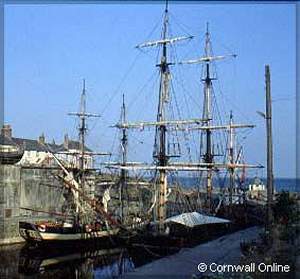 Charlestown
has a slipway which can only be used at certain states of the tide and
is very steep, or you can launch - with permission from Square Sail Ltd,
the owners - from the beach. In the well-known Charlestown
Shipwreck Centre the port boasts the largest collection of shipwreck
artefacts on public display in Britain... an excellent bad-weather venue
for divers.
Charlestown
has a slipway which can only be used at certain states of the tide and
is very steep, or you can launch - with permission from Square Sail Ltd,
the owners - from the beach. In the well-known Charlestown
Shipwreck Centre the port boasts the largest collection of shipwreck
artefacts on public display in Britain... an excellent bad-weather venue
for divers.
Fowey harbour has excellent facilities for launch, parking and diving services around Caffa Mill boat park. Here a large slipway provides easy access to the estuary No diving is allowed within the harbour without permission, but just outside the harbour mouth are long stretches of shallow reefs and the wreck of the bucket dredger Kantoeng in 45ft (13m).
West Looe is the last but one practical launch site in South Cornwall, again completely tidal and with frequent parking problems. By contrast Millendreath - a holiday village east of Looe - is seldom congested. From Millendreath beach, divers can easily reach the s.s. Rosehill, the submarine A-7, s.s. White Rose, and, almost at the entrance to Plymouth Sound, the Liberty ship James Egan Layne (1945).
Whitesand Bay offers no launch facilities, but provides excellent snorkelling or shore diving in the shallows from places such as Portwrinkle, Seaton or Downderry. The latter offers the Knight Errant Patch, a huge reef, the Sherberterry Rocks and in 30ft (8m), the wreck of the clipper Gipsy, lost in 1901.
Rame Head and Cawsand Bay are best reached by boat; the former offering several cannon sites, a rocky but interesting bottom; the latter a large sandy, almost featureless bay within Plymouth Sound. The coastline round to Torpoint embraces the dockyard entrance, where diving restrictions apply, and is therefore not recommended.
DIVING NORTH CORNWALL COAST - BUDE TO PERRANPORTH
Knap Head, at the north-east extremity of Cornwall, covers some 70 miles of high cliffs and remote rocky coves and headlands, broken only by a dozen sandy holiday beaches, which are largely unexplored - with large underwater areas little known, even to local divers. The cliffs rise to 325ft (100m), interrupted at Port Isaac, Port Quin, the Camel Estuary, Harlyn and Trevone Bays, Newquay and Perranporth.
This is a dangerous coastline offshore, and you are advised to ensure your outboard engine is reliable, carry a spare 'get-you-home' engine if possible, and always carry spare fuel, an anchor, a VHF radio and suitable distress flares.
The diving off the North Coast can be spectacular, with depths of 82ft (25m) generally available only 0.5 mile offshore, the majority of the 1,000 recorded shipwrecks lying within 130ft (40m) or 5 miles of the coast. Portreath, at the south-west end of this area offers a good launch site, with every amenity for family members left onshore, the offshore Gull Rock and the remains of the s.s. Escurial offering excellent diving
In the opposite direction, a 5 mile run to the north-east will bring you to St Agnes and the Bawden Rocks, with Newquay and its numerous offshore wrecks only 5 miles ahead.
Boat launching at Newquay harbour is possible at high-tide, but the beaches are unbelievably crowded in the holiday season. Padstow harbour, on the Camel estuary is a good base, with a concrete slipway alongside the Harbour Masters Office and a large public car park.
The Camel Estuary is tidal, and the outer harbour dries at low water Springs, so that it will be necessary to stay out until there is sufficient water to return. There is both an excellent Shipwreck and local Museum at Padstow, and compressed air is available. On the opposite shore to Padstow lies Rock, a small village which offers excellent launch facilities and does not have such a restrictive tidal window. Launching into the Camel allows easy access to Stepper and Pentire Point, the latter the site of the tragic sinking of the square-rigged Maria Assumpta in 1995, also Trevose Head and the offshore islands known as the Quies, Gulland, Newland, Mouls and Rumps.
Further north, Port Isaac is a reasonable if congested launch site, where an early start is recommended, giving access to the 1980 wreck of the MV. Castor I, literally at the harbour entrance. A short distance away in Hell Bay, can be found the remains of the Greek freighter Skopelos Sky.
It is then 23 miles further north before another easy launch site presents itself at Bude. From here it is a relatively short distance back south to Tintagel and Boscastle, where there is terrific diving in the rocky, sandy coves, which abound in colourful wrasse, dog fish, pollock and sea urchins, with many caves and rock formations.
Bude, in particular, offers easy access to many sheltered dive sites, around Dizzard Point and the Cambeak area. There are plenty of shallow and deep wreck sites here, which can be found marked on Admiralty chart No, 1178. A small local museum stands on the quay, almost opposite the RNLI Inshore Rescue Station, which features many relics from shipwrecks as well as lists of local shipwreck incidents.
For local diving information or compressed air contact the local BS-AC club at the Pool & Leisure Centre. Air is available here by prior arrangement only.
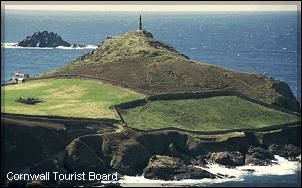 |
ST IVES BAY, ISLES OF SCILLY & MARAZION
This part of the Cornish Peninsula covers the area west of Perranporth on the North Coast, round Land's End to St Michael's Mount, including the offshore Seven Stones and Isles of Scilly. From Perranporth, round to Mousehole, near Penzance, is somewhat similar to the north coast with long stretches of unbroken cliff. St Ives harbour and the more tidal Hayle estuary are the last launch sites on the north coast until Sennen Cove, at Land's End. From here you can reach Gurnards Head, Pendeen Point, Cape Cornwall and the famous Brisons.
Fifteen miles of coast are littered with inshore steel and wooden shipwrecks, 34 colliers alone, plus the Nails Gannet, Scheldt, Busby, Paknam, William Cory and Liberty to name but a few. Offshore from Pendeen, the Three Stone Oar reef is well worth a visit for its variety of marine life and clear water but beware of strong tides.
At Land's End, Sennen Cove has three concrete slipways, two of which are restricted in use, but the larger public slip at the north end leads to a firm sandy beach, with plenty of local parking. At the north end of Sennen Cove lie the two Brison rocks, which hold the remains of the s.s. Datetree, which broke her back when wrecked in 1914, and close at hand lie the remains of the naval stores tender Devon and several other wrecks. From here it is possible to reach Cape Cornwall with ease, where can be found the small Cunard liner Malta, the Royal Navy submarine L1 and many others. South and west from Sennen Cove, lie the Longships, a huge reef on which stands the Longships Lighthouse. The remains of the s.s. Bluejacket lie in the shallows, which all but demolished the lighthouse when she struck in 1898. Between the reef and the mainland are the Armed Knight, Shark's Fin and other reefs, on which previously unknown wreck sites are still found.
Further round Land's End to the south and east lies Gwennap Head and a mile offshore, the well known Runnelstone Reef whose deep gullies and severe tidal stream and marine life are a photographers' paradise. Over 15 known steamship wrecks lie between the Runnelstone and mainland, many on top of each other or intermingled into a giant scrap heap. It is possible to explore no less than five ships in a single dive here.
Working east, Porthgwarra, a miniature cove with a small, steep slipway and half a dozen houses, also offers a launch site, but its small size makes it essential that only two or three divers make up a group. Groups who turn up en masse will be far from welcome, and possibly refused permission to launch, since it is privately owned.
Further east still, past the Bucks Rock where in 1868 the s.s. Garonne was lost - and past the remains of the SS. Avebury (lost in 1884), you come to Lamorna Cove. This is an excellent launch site, with waterside parking, amenities, toilets etc. and is highly recommended as a start point from which to explore the Land's End peninsula generally. For the beginner or snorkeller, the cove offers great shallow water diving straight out from the shoreline. Make sure you have an SMB, though, since there is a lot of boat traffic in the area in summer.
There is even an old Cromwellian cannon site in the bay in 35ft (10m) on the eastern side near Carn Du, which has yielded several silver coins. Into Mounts Bay itself, Penzance is the main base for diving facilities and launching, concentrated around the slipway and inner harbour.
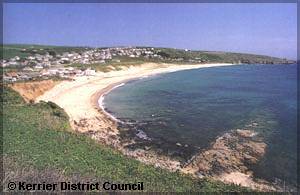 |
From Penzance it is but a short distance to St Michael's Mount and the remains of the battleship HMS Warspite, or the Stones Reef, Prussia Cove and Praa Sands. In the opposite direction lies Low Lee ledges, near Mousehole, on which can be found an abundance of marine life and the wrecks of the s.s. Primrose and an unidentified Dutch East Indiaman.
Offshore from Land's End are two great diving areas, remote, but well worth the effort to reach them. Ten miles south-west lies the Wolf Rock which rises up from a depth of 200ft (61 m) on which stands the famous lighthouse, now un-manned. The other site, lying 17 miles due west is known as the Seven Stones, famed for having sunk the super-tanker Torrey Canyon in 1967 (the largest ever shipwreck in British waters) In addition there are some 200 other wrecks in varying depths. A visit to the Stones will be an experience you will never forget.
Further west still - 24 miles from Land's End - or 40 miles by sea from Penzance, lie the magical Isles of Scilly. The five inhabited islands and some 100 islets and rocks are a paradise for divers, frequently offering underwater visibility in excess of 120ft (37m) and some of the most famous wrecks in history, including the still treasure laden men o'war Association, Eagle, Romney, Firebrand and Colossus.
There are some 900 other wrecks around the islands, including the Dutch East Indiaman Hollandia and Princess Maria, and literally dozens of cannon sites. Here you can genuinely frolic with grey seals and dolphins, explore underwater caves and deep gullies, sheer rock faces - particularly the aptly named Deep Point Pinnacles reaching up from 165ft (50m) - or simply forage through the debris left by generations of lighthouse keepers, thrown into the sea from the Bishop Rock or Round Island lights, both now fully automated.
The Scillies can be reached by helicopter, fixed wing aircraft or ferry, the latter being cheapest, particularly if you are carrying heavy diving equipment. Alternatively you can book an all-in diving holiday on one of the many 'live aboard' charter boats that visit the islands. The MV Scillonian sails daily in season, making the crossing in 3 hours, whilst the helicopters take just 20 minutes.
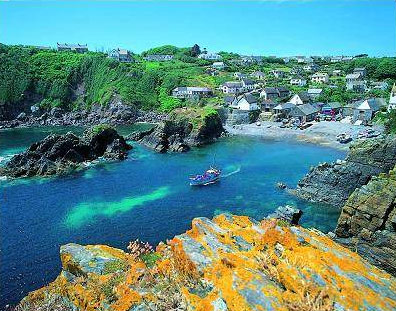 |
|
Cadgwith on the Llizard Peninsula |
|
Diving Lessons, Equipment |
|
Atlantic Scuba - Scuba Diving Centre Atlantic Scuba is based near Falmouth in Cornwall, with our dive boat moored at Mylor in the Fal Estuary. Specialising in diving around Falmouth Bay and the Manacles, the area is ideal as it is protected from the predominant south westerly winds. With years of Scuba Diving experience in Cornwall from Padstow to Plymouth we can take you to some of the best scuba diving in Cornwall and the U.K. During calm seas the visibility around Cornwall can exceed 25m and can reach over 16 degrees centigrade. Mark Milburn - 1 Trenoweth Business Park, Mabe, Penryn
Cornwall email: mark@atlantiscuba.co.uk
|
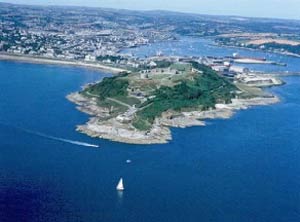 |
|
DIVING ON THE LIZARD PENINSULA - PRAA SANDS TO CARRICK ROADS
Mounts Bay stretches Mousehole to the Lizard Point, and offers completely different diving conditions, being relatively shallow and fringed with sandy beaches and plenty of launch sites for diving boats.
Porthleven, an old fishing port, offers the best facilities, giving access to the whole of the Bay, including the WW II liberty ship s.s. John R. Park in 147 ft (45m) and the s.s. Heidrun, a Norwegian collier lost with all hands in 1915. On Loe Bar in the shallows, cannon, anchor and debris from HM frigate Anson, the s.s. Brankellow and dozens of other victims can be found.
At Gunwalloe Cove snorkellers and beginners could well search for pillar-dollars from the legendary Dollar Cove wreck of 1744. Nearer Mullion - which offers excellent but limited launching facilities - see the cannon remaining from the galleon Santo Christo de Castello under Angrouse Cliff in 1667, the nearby barque Boyne or on Mullion Island, two unidentified cannon sites.
To reach the Lizard, launch at either Mullion, Cadgwith or Kennack Sands, the latter offering camping, accommodation, food and compressed air. On your way to the Lizard you will pass the recently opened Predannack Holiday Village Dive Action Watersports Centre which offers equipment hire, air, PADI training, spares and accompanied boat dives.
On the Lizard Point, under the Coastguard lookout, which is swept with fierce tides on a spring ebb of up to 5 knots, lie the s.s. Mosel, le Vieux Tigre, Clan Malcolm, Zebra, Adolf Vinnen and Cromdale, all in shallow water.
In Housel Bay, on Carn Table, can be found the barque Hansey. Offshore from the Lizard car park near the twin tower lighthouse, is a large shallow reef well worth a visit at low tide, when it is safe for snorkelling. Known as the Inner and Outer Cledges, numerous ships have come to grief here and the area is rich in marine life generally.
Cadgwith offers limited launch facilities over a stony foreshore, whereas Kennack Sands gives easy access to nearby Black Head, again littered with wrecks: the s.s. Belucia, Carmarthen, Gunvor, Clan Alpine, Brielle and Dispatch. Coverack slipway will lead divers to the Manacles which is legendary for the 112 ships lost here long ago, attempting to reach Falmouth harbour.
An offshore reef over one mile square, the Manacles offers everything the underwater enthusiast could want. The most popular wreck here is the liner s.s. Mohegan, lost with 106 lives in 1898. She lies on the easternmost edge of the reef in 75ft (22m) depth, a great mass - 7,000 tons - of steel.
The closest launch site is Porthoustock, a steep shingle beach, popular with diving groups, which suffers frequently from 'diver congestion'. Signs at Porthoustock indicate the 'no-go' areas for divers, and you are requested to read the instructions and observe the necessary restrictions. Compressed air is available from the inn at St Keverne, just inland, or every facility you could want can be found at the Polkerris Dive Centre, less than a mile further north. Here you can hire equipment, have a tracked vehicle launch and recover your boat, eat and drink, recharge your cylinders, take a training course or join one of their regular dive boat trips.
Falmouth makes a superb base for a diving group, with accommodation, entertainment, diver support, charter boats and the largest public concrete slipway in Cornwall.
There are many dive sites in Carrick Roads, but contact the Harbour Office for permission first. Otherwise dive in Falmouth Bay, on the many charted wrecks, including the remains of five German submarines, but keep clear of any large vessels on the move.
Local diving establishments offer local knowledge, advice, equipment and air.

